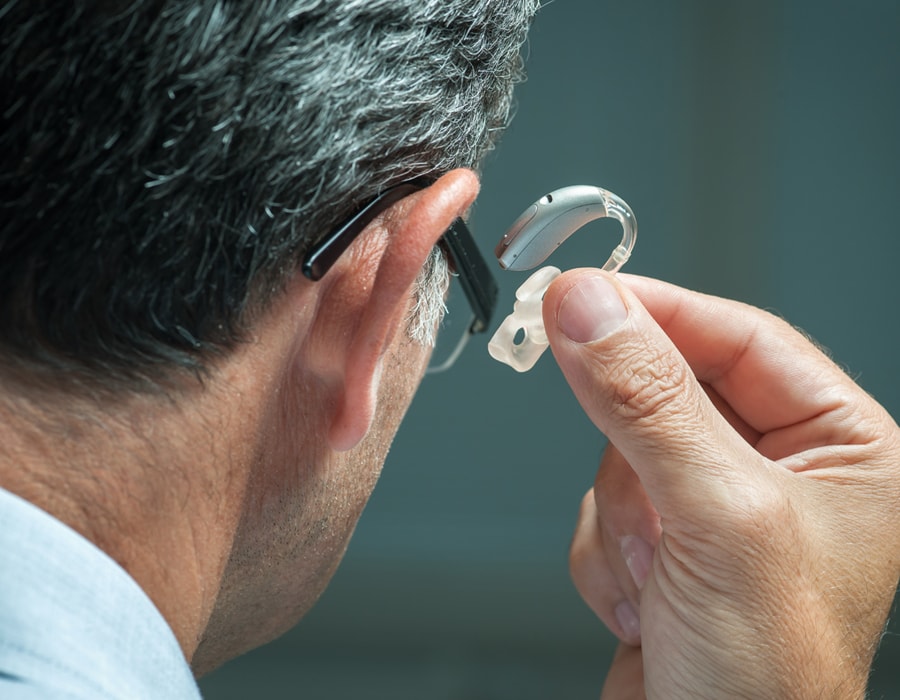EXCLUSIVE: Beyond amplification – The role of hearing aids in tinnitus management

Adriana Aleksandrova, Content Writer and Consultant for Hear4U, delves into the evolving role of hearing aids, not just as tools for amplification, but as instrumental devices in the management of tinnitus.
Hearing aids, for the longest time, have been synonymous with sound amplification. However, their role is far more intricate in today’s technologically advanced landscape. Beyond merely enhancing sound clarity, these devices have emerged as powerful tools in the battle against tinnitus, a pervasive condition marked by constant ringing, buzzing, or hissing in the ears.
As around 13 percent of adults in the UK—that’s a staggering 7.1 million people—experience prolonged tinnitus, the importance of addressing this issue becomes increasingly evident. Moreover, with the prevalence of tinnitus rising with age and the UK population ageing, the integration of its management within hearing technology becomes more critical than ever.
This article dives into the complex relationship between hearing aids and tinnitus, exploring how modern devices are designed not only to amplify sound but also to mitigate the disruptive symptoms of this condition.
The science of tinnitus and amplification
-
How tinnitus arises
Tinnitus is more than just an auditory annoyance; it’s rooted in complex psychological and neural processes.
Various theories have been proposed regarding its cause. According to one of those, the condition stems from damage to the hair cells within the cochlea, the spiral-shaped part of the inner ear. These hair cells are responsible for translating the vibrations caused by sound waves into electrical signals, which the brain interprets as sound. When these cells get damaged – often due to prolonged exposure to loud noises or age-related wear and tear – they can send random, spontaneous electrical signals to the brain, resulting in the perception of sound when none is present externally.
Additionally, neural changes in how the brain processes sound can also contribute to tinnitus, further illustrating the intricate nature of this condition.
-
The role of hearing loss
There’s a notable overlap between tinnitus and hearing loss, with many individuals experiencing both simultaneously. In fact, a remarkable 80 percent of tinnitus cases come with some form of underlying hearing issues.
Hearing loss often results from the same damage to the hair cells that can lead to tinnitus. When the auditory pathway doesn’t receive the expected amount of sound information due to hearing loss, the brain sometimes compensates by becoming more sensitive and overactive. This heightened neural activity can manifest as tinnitus.
Essentially, the quieter external environment due to hearing loss can make the internal noise of tinnitus more pronounced.
-
Amplification as a natural masker
One might wonder how amplifying sounds could benefit someone already plagued by unwanted noises. The principle here is simple yet effective.
At its core, our auditory system is designed not just to hear but to selectively focus on specific sounds while filtering out others. This capability, known as auditory attention, is crucial in our daily interactions, enabling us to concentrate on a conversation in a noisy room or tune into a distant bird’s song.
Tinnitus, with its persistent and often invasive noise, challenges this system, dominating our auditory focus. However, by amplifying ambient sounds, modern hearing aids offer a countermeasure. They reintroduce a plethora of external sounds, providing the auditory system with a richer landscape to navigate.
This influx of genuine sound can overshadow or ‘mask’ the internal noise generated by tinnitus, rendering it less noticeable. By making the external environment audibly richer, the prominence of tinnitus can be reduced, giving individuals a much-needed respite from the constant ringing or buzzing.
The psychological component
The incessant nature of tinnitus isn’t just an auditory concern; it’s a psychological one. The continuous ringing or buzzing can lead to heightened levels of stress and anxiety, which, in turn, are thought to trigger or exacerbate tinnitus symptoms. This can create a vicious cycle where these negative emotions further amplify the perception of tinnitus.
But there’s a flip side. Effectively managing tinnitus through sound masking can break this cycle. As individuals gain relief from the persistent noise, their stress and anxiety levels can decrease. Moreover, knowing that they have a tool at their disposal to manage tinnitus can provide a sense of control and empowerment, further contributing to their psychological wellbeing. It’s a ripple effect: by addressing the root auditory issue, there’s a cascading benefit that positively impacts broader mental health.
Real-world application: What research reveals
-
The positive impact of hearing aids on tinnitus
Several studies have delved into the efficacy of hearing aids in tinnitus management, and the results are promising. In one particular study, a compelling 85 percent of patients noted an improvement in their tinnitus symptoms after being equipped with a hearing aid and undergoing counselling. This was a significant increase from the 73.3 percent of patients who only received counselling. Another review article further consolidates this finding, with a positive impact of hearing aids on tinnitus relief being demonstrated in 68 percent of the studies reviewed.
-
Hearing aid effectiveness over time
The benefits of hearing aids for tinnitus management are not just immediate but also enduring. A study focusing on patients with chronic tinnitus accompanied by hearing loss sheds light on this sustained impact. After six months of consistent hearing aid usage, there was a clinically and statistically significant reduction in tinnitus annoyance. Furthermore, minimal masking levels, which indicate the intensity of sound needed to mask tinnitus, showed a notable decrease after this six-month period.
Intriguingly, the study also found an inverse correlation between the duration of tinnitus and the effectiveness of hearing aids, underscoring the value of early intervention.
-
The importance of continuous adjustments
While the aforementioned findings highlight the potential benefits of hearing aids, it’s crucial to recognise that tinnitus management is an ongoing process. Regular consultations with audiologists are indispensable. These sessions allow for fine-tuning of the hearing aid settings, ensuring that they are optimised for each individual’s unique auditory needs, and facilitating continued relief from tinnitus symptoms.

Modern hearing aids: Built-in tinnitus maskers
-
Emergence of tinnitus-specific features
Today’s hearing aids are a far cry from their predecessors, moving beyond mere amplification to cater to a wide range of auditory challenges, chief among them being tinnitus.
Recognising the widespread prevalence of tinnitus and its debilitating impact, hearing aid manufacturers have prioritised the integration of tinnitus-specific features. These advancements signify a pivotal shift in hearing technology, acknowledging the intertwined nature of hearing loss and tinnitus and the need to address both concurrently.
-
White noise and other sounds
One of the groundbreaking innovations in modern hearing aids is their ability to generate a range of sounds specifically designed to mask tinnitus. White noise, with its equal intensity across all audible frequencies, often serves as the default masking sound, effectively drowning out the intrusive noises of tinnitus.
However, the palette of sound doesn’t end there. Many devices now offer a suite of natural sounds, like waves crashing or rain falling, which can be both soothing and effective in masking tinnitus. The idea is to provide auditory relief by introducing external sounds that divert attention from the internal noise, enabling users to focus on the world around them.
-
Customisability
It’s not just the breadth of sounds that set modern hearing aids apart, but also the depth of personalisation they offer. Recognising that tinnitus manifests differently in every individual, hearing aids now allow users to fine-tune the masking sounds to their unique needs.
Whether it’s adjusting the volume, changing the frequency, or selecting a specific sound profile, users have an unprecedented level of control. This degree of customisation ensures that the hearing aid isn’t just a device, but a tailored solution, addressing tinnitus in a way that’s most effective for each individual. The benefit of this personalised approach is twofold: it offers relief from tinnitus and empowers users, giving them agency over their auditory experience.
Practical solutions: Hearing aids designed for tinnitus relief
As we navigate through the myriad of options in tinnitus management, it’s essential to spotlight some of the leading-edge hearing aids that have integrated innovative tinnitus-relief features. These devices not only exemplify the merging of technology with user needs but also underscore the industry’s commitment to delivering holistic auditory solutions:
-
Signia Styletto X
Signia’s Styletto X is renowned for its multi-faceted approach to tinnitus relief. The device incorporates three distinct mechanisms:
- Static Noise: Traditional white noise to mask tinnitus sounds.
- Ocean Wave Sounds: Calming ambient noises that mimic the ebb and flow of the seaside.
- Notch Therapy: A pioneering technique tailored to pinpoint the user’s specific tinnitus frequency. By establishing an auditory ‘quiet zone’ around this frequency, Signia asserts that Notch Therapy not only minimises the intrusion of tinnitus but has the potential to render it imperceptible in some cases.
-
Oticon More and Oticon Own
Oticon’s models come equipped with their bespoke Tinnitus SoundSupport feature. This allows users to play a diverse array of soothing sounds, including wave-like patterns and white noise. The standout feature? Users have the autonomy to adjust these sounds, ensuring the relief they seek is always at their fingertips.
-
Phonak Audéo Lumity
Phonak ventures beyond conventional tinnitus solutions with its Lumity model:
- Sound Therapy Integration: Including Tinnitus Retraining Therapy, this device facilitates enhanced customisation via the Phonak Target software.
- Phonak’s Tinnitus Balance App: Users can seamlessly connect with up to eight devices, leveraging two simultaneously. This facilitates an expansive audio palette for tinnitus relief, from classic white noise to personal preferences like the hum of a fan.
-
ReSound Omnia
ReSound Omnia is all about user empowerment. Through the ReSound Relief App, users can:
- Craft personalised soundscapes, merging up to five distinct sounds, such as white noise or music.
- Access meditation and relaxation practices, offering a buffer during intense tinnitus episodes.
-
Widex Moment Sheer
The Moment Sheer by Widex offers a distinctive solution with its Zen Therapy Tones. Unique to Widex, these tones:
- Serve as relaxing, fractal melodies that soothe the user.
- Complement a broader tinnitus therapy strategy, ensuring a holistic approach to symptom relief.
-
Starkey Livio Edge AI
Starkey’s Livio Edge AI stands out for its adaptable soundscapes, allowing for user or professional adjustments tailored to offer tinnitus relief. Moreover, its Relax app enhances the experience with an array of soundscapes, augmented with visuals, to further aid in alleviating tinnitus symptoms.
Conclusion
In the realm of auditory health, hearing aids have long been heralded for their primary function – restoring lost soundscapes and enhancing auditory experiences. Yet, as we’ve delved deeper into the intricate complexities of the ear, it’s become clear that the scope of these devices transcends mere amplification. They stand as dual-purpose tools, not only bridging gaps in our auditory world but also offering significant relief from the pervasive and often distressing symptoms of tinnitus. The nexus between hearing loss and tinnitus highlights the indispensable role of hearing aids in managing both.
For those living with the persistent hums, rings, or buzzes of tinnitus, there’s more than just hope; there’s actionable relief. Modern hearing aids, equipped with advanced technology and integrative capabilities, offer a comprehensive solution to combat the challenges tinnitus presents. If you or someone you know grapples with these symptoms, don’t wait. Reach out to an audiologist. Understand your auditory landscape, explore the potential of hearing aids, and embark on a path to enhanced auditory well-being. Your ears do more than just hear; they connect you to the world. Ensure they’re given the care and support they truly deserve.

